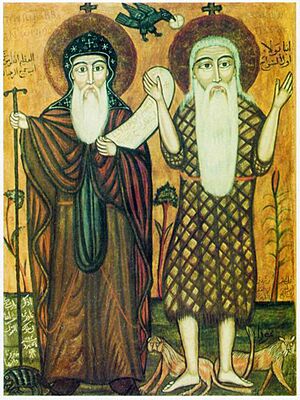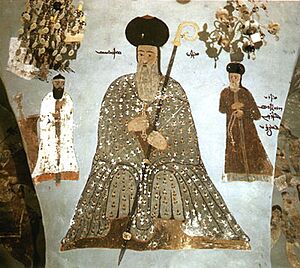History of Oriental Orthodoxy facts for kids
Oriental Orthodoxy is a group of Christian Churches that are mainly found in the Middle East, Africa, and India. These Churches follow the teachings of the first three big Church meetings, called ecumenical councils. These were the First Council of Nicaea, the First Council of Constantinople, and the Council of Ephesus.
However, they do not accept the decisions made at a later meeting, the Council of Chalcedon. Because of this, they are sometimes called the Old Oriental Churches or Non-Chalcedonian Churches.
Contents
Early History of Oriental Orthodoxy
The history of these Churches goes way back to the very beginning of Christianity. They played a big part in spreading Christianity in its early days, especially in places like Egypt.
The Split at Chalcedon
A big split happened in the Christian Church in the 400s. Before this, important leaders called Patriarchs led the Church in major cities like Rome, Alexandria, Antioch, and Constantinople. The leader in Rome was seen as the "first among equals."
The split happened because of disagreements about Jesus. The Council of Chalcedon decided that Jesus had two distinct natures: one fully divine and one fully human. However, the Oriental Orthodox Churches believed that Jesus's two natures were always united and inseparable. They said it was "of or from two natures," but not "in two natures."
The leader of the Church in Alexandria, Dioscorus, did not agree with the Council's decision. He and others felt that the Council's teaching sounded too much like Nestorianism, which they believed was wrong. Instead, they followed a teaching called Miaphysitism. This teaching strongly focused on the complete unity of Jesus's divine and human natures.
Because of this, the Oriental Orthodox Churches were sometimes wrongly called "monophysites." They prefer to be called "non-Chalcedonian" or "Miaphysite" Churches. They rejected both the teachings of Eutyches (which was a type of Monophysitism) and Nestorius, as well as the definition from Chalcedon. In 451, the leaders of Rome and Constantinople officially separated from the Oriental Patriarchs. This made the split formal.
While the main reason for the split was about Jesus's nature, other things also played a part. These included political issues and disagreements about Church power.
Attempts to Reunite
After the split, there were attempts to bring the Churches back together. In 482, the Byzantine emperor Zeno tried to fix the differences with a decree called the Henotikon. But these efforts were mostly political and did not truly heal the divide.
For a while, the Patriarch of Constantinople stayed in touch with the non-Chalcedonian Patriarchs. But Rome was not in communion with them. Later, in 518, the new Byzantine Emperor, Justin I, demanded that everyone in the Roman Empire accept the Council of Chalcedon's decisions. He even replaced non-Chalcedonian bishops.
During the rule of Emperor Justinian I (527–565), more attempts were made to reunite the Churches. One important Oriental Orthodox thinker at this time was Severus of Antioch. Even with many meetings, no final agreement was reached. The split became permanent. Soon, separate Church groups formed across the Near East. A key Oriental Orthodox leader in the 500s was Jacob Baradaeus. His followers became known as "Jacobite" Christians.
Life Under Different Empires
In the 500s and 600s, there were many wars between the Byzantine Empire and the Sasanian Empire (Persia). These wars greatly affected Christians in the Middle East, including the Oriental Orthodox. When Persia temporarily took over areas like Armenia, Syria, and Egypt, it made the Oriental Orthodox communities feel even more separate from the Byzantine government in Constantinople.
Even after the Byzantines took back these lands, relations did not get better. Emperor Heraclius tried to unite the Christian groups by suggesting new ideas about Jesus's nature, but he was not successful.
After the Arab Conquests
When Muslim armies conquered the Middle East in the 600s, a process of Islamization began. This slowly changed the lives of all Christians, including the Oriental Orthodox. Many Oriental Orthodox Christians, like the Syriac and Coptic people, became minorities. However, a group of them held onto their Christian faith and culture.
Later, in the early 1500s, the Ottoman Empire took control of the Near East. The Ottoman government created a system called the millet system. This system gave non-Islamic religious groups, including Oriental Orthodox Christians, some freedom to govern themselves.
Challenges and Persecution
Throughout history, Oriental Orthodox Christians have faced many challenges and times of persecution. This happened under the Byzantines, the Sasanids, and later under various Muslim rulers.
In the Byzantine Empire, after the Council of Chalcedon in 451, there were religious divisions. This led to persecution of Oriental Orthodox Christians, especially in Egypt.
After the Muslim conquest of Egypt in 639 AD, Egypt remained mostly Christian for a long time. However, Copts (Egyptian Oriental Orthodox Christians) became a minority after the 1300s. This was due to times of persecution, churches being destroyed, and high taxes for those who did not convert to Islam. From that time on, Coptic Christians faced challenges from different Muslim governments. This included churches being closed or destroyed, and some people being forced to convert to Islam. Even today, Christians make up about 10% of Egypt's population, and most of them are Oriental Orthodox. There have been recent attacks targeting Coptic Christians, such as church bombings and attacks on pilgrims.
In more recent times, Oriental Orthodox Christians faced severe persecution during the First World War. The Ottoman Empire carried out systematic attacks against Armenian Christians and Assyrian Christians. These terrible events are known as the Armenian genocide and the Assyrian genocide.
On April 23, 2015, the Armenian Apostolic Church honored all the victims of the Armenian genocide as saints. This was a very large ceremony. It is believed that around 1.5 million people were victims of the Armenian genocide.
Oriental Orthodoxy Today
Today, the Oriental Orthodox communion includes six main groups:
- Coptic Orthodox
- Syriac Orthodox
- Ethiopian Orthodox
- Eritrean Orthodox
- Malankara Orthodox Syrian Church (in India)
- Armenian Apostolic
These six Churches are in communion with each other, meaning they recognize each other as true Churches. However, they are independent and do not have one shared leader.
In the 1900s, the old disagreements from the Chalcedonian Schism became less important. There have been meetings between the Catholic Church and Oriental Orthodox Churches. In 1984, leaders from both sides, including Patriarch Ignatius Zakka I Iwas and Pope John Paul II, signed statements of reconciliation.
They agreed that:
The disagreements and splits that happened between their Churches in later centuries, they now realize, do not affect the main part of their faith. These problems only came from different words and cultures, and different ways of explaining the same beliefs. So, today we find no real reason for the sad divisions that happened between us about the teaching of Jesus becoming human. In our words and lives, we believe the true teaching about Christ our Lord, even with the different ways of explaining it that came up around the time of the Council of Chalcedon.
Working with Other Churches
After a big meeting in Addis Ababa in 1965, the main Oriental Orthodox Churches started to talk more with each other. They also began to work together on their relationships with other Christian Churches, especially the Eastern Orthodox Churches and the Anglican Communion.
Discussions between Oriental Orthodox and Eastern Orthodox thinkers have mostly focused on questions about Jesus's nature. Talks between Oriental Orthodox and Anglican thinkers have also looked at questions about the Holy Spirit. In 2001, the "Anglican-Oriental Orthodox International Commission" was formed. This group has made important statements about their shared beliefs. In 2017, they met in Dublin and signed an agreement on questions about the Holy Spirit. This agreement confirmed that Anglicans were willing to remove the Filioque (a phrase about the Holy Spirit) from the Creed.
See also
- Conference of Addis Ababa
- History of Christianity
- Coptic history



